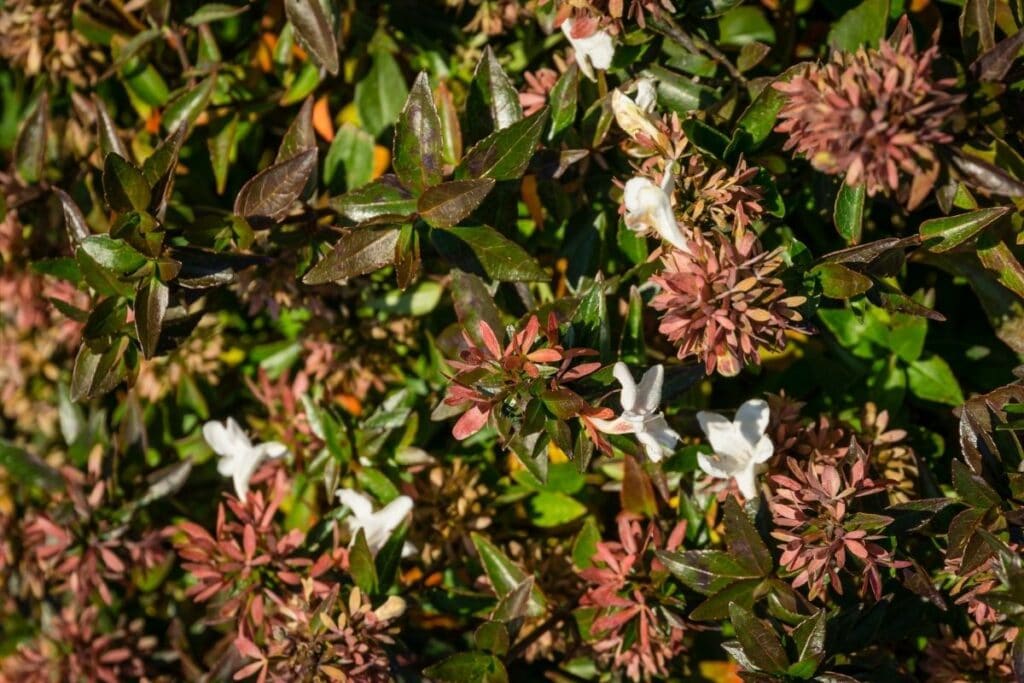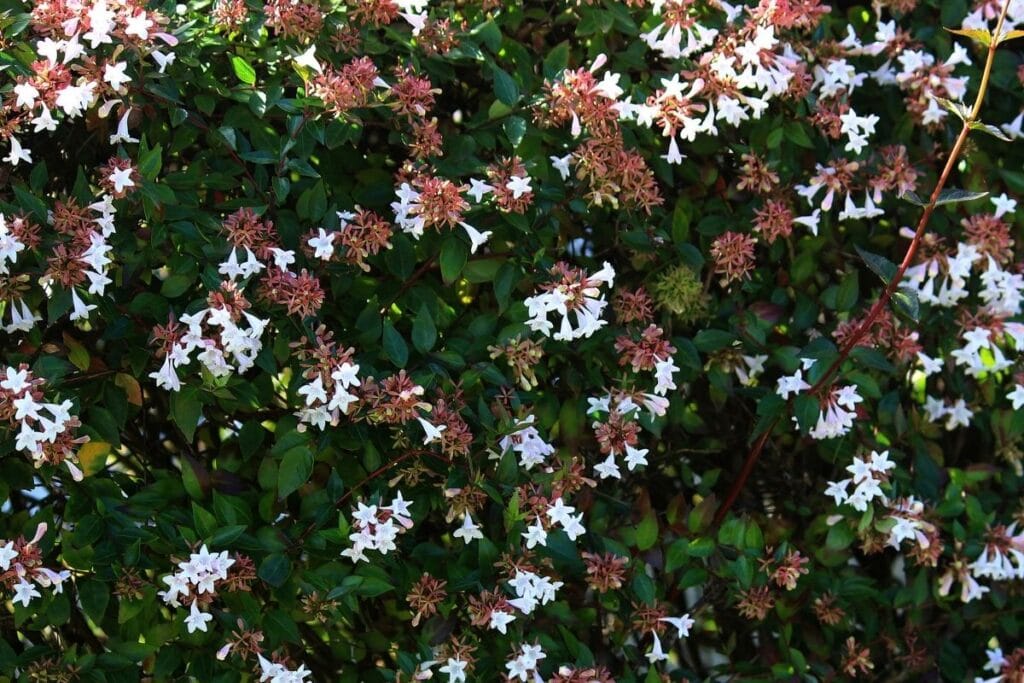Abelia is a very tough and hardy flowering shrub that has a long flowering period and needs very little attention from the gardener. If you’re looking for a virtually maintenance-free, fragrant plant with a multitude of uses in the landscape, this might be just the plant for you.
Read on to learn more about how to grow and care for the glossy abelia.
What Is A Glossy Abelia Shrub?
Glossy abelia is a hybrid shrub species from the Caprifoliaceae family that is technically known as Linnaea x grandiflora (previously Abelia x grandiflora). (1) These popular plants are a cross between two east Asian species, L. chinensis and L. uniflora.
This is a broadleaf multistemmed shrub that has a mounding growth form. Depending on the severity of the winter temperatures, this plant may be evergreen, semi-evergreen, deciduous or even a resprouting perennial.
There are many cultivars available that come in varying sizes, but the largest glossy abelias reach a height of about 8 feet (2.4 m).
The foliage consists of glossy green leaves that are oppositely arranged. The leaves are typically a little over an inch (2.5 cm) long and dark green. New growth has pinkish hues, and fall foliage turns a beautiful bronzy shade.
Mature plants have attractive, peeling bark, and reddish young stems.

Glossy Abelia Flowers
This shrub puts on quite a floral show, providing a long, continuous flowering period that may begin as early as late spring, and run on into the start of winter. In the spring, the flower buds of this plant are produced.
Depending on the variety, the flowers are mildly fragrant and shaped like bells, ranging from pinkish white to pure white. Glossy Abelia flowers attract pollinators such as bees, butterflies, and hummingbirds to the garden with their sweet fragrance and long blooming period from spring to fall.
The glossy, dark green leaves serves as a lovely backdrop for the profusion of blooms, creating a striking contrast and enhancing the overall appeal of the shrub. Whether planted as a specimen shrub, hedge, or border plant, these pink blooms provide a delightful display of color and fragrance throughout the growing season.
Cultivars
There is a wide variety of glossy abelia cultivars available. Some of the most popular options include:
- ‘Edward Goucher’ – This compact form grows from 3 to 5 feet (0.9 to 1.5 m) tall and is popular for its bronze fall foliage and light pink flowers.
- ‘Kaleidoscope’ – With an extra-long bloom-time and variegated foliage that changes color from golden yellow, through bright green to rich orange-red, this cultivar makes a fine specimen. These are small shrubs that grow to about 2 ½ feet (0.75 m) tall and a little wider.
- ‘Little Richard’- This cultivar grows to about 3 feet (0.9 m) tall and produces fragrant white flowers. The foliage is variegated and dark green, becoming a beautiful shade of purple in the fall.
- ‘Rose Creek’ – This cultivar has beautiful pink-tinted new growth and a compact, low-growing form of 3 feet (0.9 m) or less. It produces white flowers about ½ inch (13 mm) long.
How To Grow A Glossy Abelia
Sunlight
Choose a location for your Glossy Abelia that receives full sun to partial shade.
While it can tolerate some shade, ample sunlight encourages robust growth and flowering, meaning it prefers a minimum of 4 hours of direct, unfiltered sunlight each day.
Water
Water your bell shaped flowers regularly for the first 8 weeks after planting to encourage new roots to grow. Aim to provide the young plant with about 1 inch of water per week.
Once established, the shrub is moderately drought-tolerant and requires less frequent watering. Water deeply during dry spells, allowing the water to penetrate the root zone.
Soil
Glossy abelia prefers well-draining soil that is rich in organic matter, such as compost or well-rotted manure, to improve drainage and fertility.
Glossy Abelia also grows best in slightly acidic to neutral soil with a pH range of 6.0 to 7.0. Avoid planting in heavy clay soils, as they can lead to waterlogged conditions and root rot.
Fertilizer
Fertilize Glossy Abelia in the spring with a balanced, slow-release fertilizer formulated for flowering shrubs.
Avoid overfertilizing, as excessive nitrogen can promote lush foliage at the expense of flowering. Supplemental fertilization may not be necessary if the shrub is planted in nutrient-rich soil.
Common Pests and Diseases
Glossy Abelia is relatively resistant to pests and diseases, but it may occasionally encounter issues such as aphids, spider mites, or powdery mildew.
Check the plant often for signs of pests or diseases, and if you see any, move quickly to fix the problem.
Insecticidal soap or horticultural oils that kill insects can help get rid of bug problems, but fungicides may be needed to get rid of fungus diseases.

Care and Maintenance
Glossy Abelia shrub is easy to grow and will thrive without much attention.
Prune Glossy Abelia in late winter or early spring to maintain its shape, remove dead or diseased branches, and encourage new growth. Use sharp, clean pruning shears to make cuts at a 45-degree angle, just above a leaf node or lateral branch. Avoid heavy pruning, as Glossy Abelia blooms on old wood, and excessive cutting can reduce flowering.
In regions with harsh winters, provide winter protection for Glossy Abelia by mulching around the base of the shrub and wrapping it with burlap or frost cloth during extreme cold spells. Avoid pruning in late summer or fall, as it can stimulate new growth that is susceptible to frost damage.
Uses
Horticultural Uses
Glossy abelia makes a great foundation plant, particularly the smaller cultivars. These types of shrubs have so many uses in the landscape, however. You can learn more about kaleidoscope abelia companion plants to get more landscaping ideas.
They are showy enough to use as an accent plant but sturdy enough for more utilitarian uses like hedging, borders, and screens. The smaller cultivars also make great container plants.
Wildlife Uses
The long-lasting, fragrant blossoms of this plant are highly attractive to pollinators like bees, butterflies, and hummingbirds. Deer, however, tend to leave this plant alone.
FAQs
What is glossy Abelia used for?
Glossy Abelia is commonly used in landscaping for its attractive foliage, colorful flowers, and ability to attract pollinators. It can be planted as a hedge, specimen plant, or in mixed borders.
Is glossy Abelia fast growing?
Yes, Glossy Abelia is considered moderately fast-growing, typically adding about 12-18 inches of growth per year under optimal conditions.
Is Abelia edible?
While Abelia plants are not typically grown for consumption, there are no known toxicities associated with them, and their flowers can be attractive to pollinators.
Does glossy Abelia flower?
Yes, Glossy Abelia produces small, fragrant flowers in clusters during the early summer and fall months, which are a significant ornamental feature of the plant.
Conclusion
What could be better than a compact, showy and fragrant flowering shrub that is tough and needs very little maintenance? Glossy abelia ticks all the right boxes and is highly recommended for landscaping in zones 6 to 9.
References
References List:
1) Gilman, E. F., Klein, R. W. & Hansen, G. Abelia X Grandiflora: Glossy Abelia
https://edis.ifas.ufl.edu/publication/fp001
2) Toogood, A. Plant Propagation, The Fully Illustrated Plant By Plant Manual Of Practical Techniques.
3) Albritton, L. Glossy Abelia
http://griffingarden.latech.edu/PlantPDFs/01%20Glossy%20Abelia.pdf
Close
*image by Marinodenisenko&Wirestock/depositphotos






